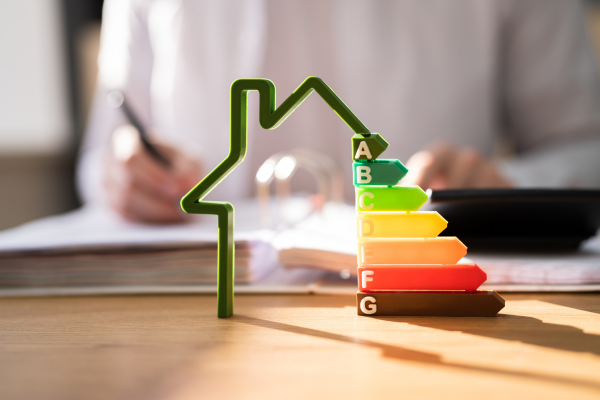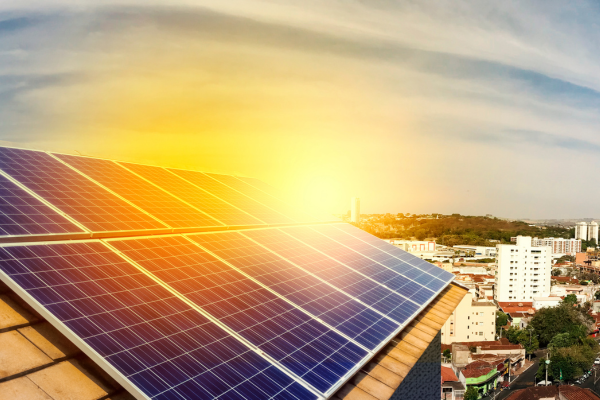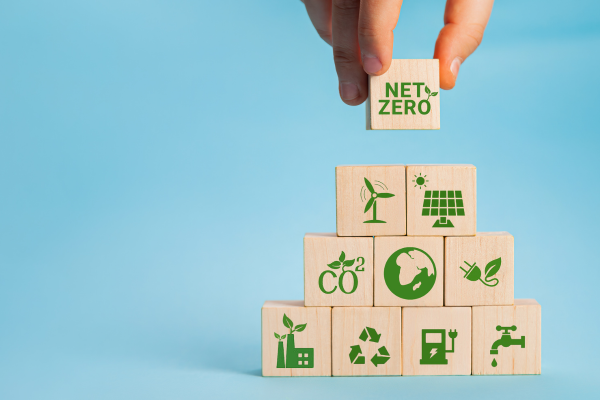.png)
Zero-Energy Buildings: The Future is Now
In our rapidly changing world, as climate concerns grow and environmental awareness spreads, the architecture of our urban landscapes isn't just a reflection of progress but of responsibility. The AEC (Architecture, Engineering, and Construction) industry plays a pivotal role in the global carbon footprint, with buildings accounting for nearly 40% of global energy consumption. A beacon of hope and innovation emerges amid these challenges: Zero-Energy Buildings (ZEBs).
Grasping the Zero-Energy Vision
ZEBs are more than mere structures; they symbolize a harmonious blend of design, technology, and nature. By definition, these buildings produce as much energy as they consume over a year. This equilibrium is achieved through a combination of energy efficiency measures and renewable energy technologies.

The Evolution: From Conventional to Sustainable
Before diving deep into ZEBs, it's essential to understand how the conventional building landscape has evolved. Traditional buildings, designed with a primary focus on comfort and utility, often heavily rely on fossil fuels for heating, cooling, and electricity. These energy sources, while effective, have significant environmental and economic consequences.
ZEBs challenge this status quo. They're rooted in a philosophy that prioritizes harmony with the environment. The shift isn't just technological; it represents a fundamental change in how we perceive buildings and their place in the world.
Harnessing Mother Nature: Beyond Traditional Renewables
Solar panels and wind turbines are often the poster children of renewable energy. While integral to the ZEB concept, there's a broader palette of innovative technologies that these buildings can utilize. Geothermal energy taps into the Earth's stable underground temperatures to provide heating and cooling. Rainwater harvesting systems collect, store, and purify rain for household and landscaping use, lessening the strain on municipal resources.
Even in architectural design, the power of nature is harnessed. Passive solar designs use building orientation, window placement, and thermal mass to capture and store the sun's energy. Green roofs not only provide insulation but also manage stormwater and enhance biodiversity.
Reimagining Spaces: The Indoor Environment of ZEBs
ZEBs aren't just about energy balance; they promise enhanced living and working conditions. By leveraging natural light, ensuring consistent air quality, and maintaining optimal temperatures, these buildings offer environments that boost productivity, health, and well-being.
Research has shown that well-ventilated, naturally lit spaces can enhance mood, increase focus, and reduce illness. ZEBs, with their emphasis on such design elements, can redefine our indoor experience, making spaces more human-centric.

The Broader Economic Canvas
The financial narrative around ZEBs is multi-dimensional. Detractors often point to the higher initial investment required. However, when viewed through a broader lens, the economic appeal becomes evident.
Firstly, the recurring savings on energy bills provide a steady offset against the initial costs. Over a building's lifespan, these savings can be substantial, often surpassing the upfront investment.
Furthermore, as governments globally prioritize green initiatives, various incentives are emerging. Tax breaks, grants, and subsidies can significantly reduce the economic burden, making ZEBs a lucrative proposition for developers and homeowners alike.
Additionally, the demand for green buildings is rising. A ZEB certification or its equivalent can increase property value, providing an edge in the competitive real estate market.
Societal Implications: Building Communities of Tomorrow
The potential of ZEBs isn't restricted to individual structures. Envision entire neighborhoods or even cities designed on zero-energy principles. Such communities can benefit from shared resources, interconnected renewable energy grids, and collaborative waste management systems. The sum then becomes greater than its parts, with every ZEB contributing to a larger ecosystem of sustainability.
This approach can transform urban planning. Parks could double up as rainwater catchment areas, streets can be designed to optimize shade, and community centers could serve as hubs for renewable energy education and innovation.
Education and Skill Development: Fueling the ZEB Revolution
For the ZEB movement to gain momentum, it's imperative to invest in education and skill development. Architects, engineers, and builders need to be equipped with the latest in green building technologies and practices. Universities, technical institutes, and vocational centers must revise and update their curriculums to ensure that the next generation of AEC professionals is ZEB-ready.
Moreover, public awareness campaigns can play a pivotal role. Homeowners, business owners, and developers need to understand the long-term benefits of ZEBs, both for the environment and their wallets.
Challenges of ZEB
1. Initial High Costs: The Barrier: ZEBs typically demand a higher initial investment than conventional buildings. Incorporating energy-efficient technologies and systems can strain initial budgets. The Opportunity: The advancement of renewable energy tech and economies of scale promises to lower costs in the future. Moreover, the savings on energy bills over time can offset this initial price tag.
2. Technological Limitations: The Barrier: While we’ve made leaps in renewable energy, some technologies like energy storage are yet to be perfected. Without effective storage solutions, the promise of ZEBs can be hindered. The Opportunity: This technological gap invites innovation. As research intensifies in battery storage and energy efficiency, we're likely to witness groundbreaking solutions that could redefine ZEBs and broader energy paradigms.
3. Climate and Geographic Constraints: The Barrier: Not all locations are suitable for harnessing renewable energy. A building in a cloudy region might struggle to generate energy from solar panels consistently. The Opportunity: Such constraints push architects and engineers towards innovative solutions, such as integrating multiple renewable sources or tapping into less conventional energy sources like piezoelectric floors.
4. Lack of Awareness and Skilled Workforce: The Barrier: The concept of ZEBs, while gaining traction, is still new. A lack of awareness can result in reluctance to adopt, and a dearth of skilled professionals can hamper the development of ZEBs. The Opportunity: This highlights the need for educational campaigns and specialized training programs. As the ZEB sector grows, it could give rise to a niche job market catering specifically to sustainable building practices.
Opportunities of ZEB
1. Catalyst for Policy Changes: ZEBs could influence policymakers to introduce incentives or mandates promoting sustainable architecture. This could range from tax breaks to grants, accelerating the ZEB movement.
2. Push for Integrated Renewable Solutions: As more buildings aim for zero energy, there's likely to be a drive for integrating multiple renewable sources, from solar and wind to geothermal, ensuring consistent energy production.
3. Boost to Green Building Materials: The demand for ZEBs can stimulate the market for sustainable building materials, such as green insulation or sustainable concrete. This not only benefits ZEBs but can enhance the overall building sector's eco-friendliness.
4. A Symbol of Environmental Responsibility: ZEBs can serve as a visual and functional representation of a commitment to sustainability, influencing communities, businesses, and individuals to adopt greener practices.

Looking Forward
The journey of ZEBs is akin to navigating a terrain with its ups and downs. While challenges are undeniably present, they serve as a nudge, pushing the boundaries of innovation and adaptability. The inherent opportunities within these challenges can mold the future of architecture, energy consumption, and our relationship with the environment.
With every ZEB constructed, we're not just building a structure; we're laying the foundation for a sustainable future. The blend of challenges and opportunities promises a vibrant, evolving landscape for ZEBs, positioning them at the forefront of a sustainable architectural revolution.
Where Are We Seeing ZEBs Today?
ZEBs aren't futuristic concepts or mere prototypes; they are springing up around the globe.
1. Educational Institutions: Universities like the University of California, Davis, have embraced ZEB principles. Their 'West Village' housing complex is the largest planned zero-net energy community in the U.S. It's an inspiration to students and a real-world model for sustainable living.
2. Corporate Headquarters: Some big tech companies, always looking to push boundaries, have ZEBs for their offices. Their drive isn't just for the environment but to showcase innovation and attract talent who prioritize sustainability.
3. Residential Projects: There’s a growing trend among homeowners wanting ZEBs. Whether it's a new build or retrofitting existing homes with energy-efficient appliances and solar panels, the residential sector is buzzing.
Research Updates: What's New in the ZEB World?
The realm of ZEBs isn't static. It's an area bursting with innovation and research.
1. Integrated Renewable Technologies: Researchers are looking beyond solar panels. Integrations of wind turbines, geothermal energy, and even energy-harvesting windows are on the horizon.
2. Smart Building Systems: Imagine a building that “thinks.” By integrating Artificial Intelligence (AI) and Internet of Things (IoT) technologies, future ZEBs will adjust heating, lighting, and cooling in real-time, optimizing energy usage based on the occupants' needs.
3. Materials Advancement: The development of phase-change materials that store and release heat and the use of advanced insulating materials like aerogels have the potential to redefine the energy conservation within buildings.
The Larger Implication of ZEBs
ZEBs matter. They are environmentally friendly, reducing greenhouse gas emissions that traditional buildings contribute massively to. They may require a substantial initial investment, but in the long run, their operational costs are drastically reduced. Besides, with renewable energy tech getting more affordable, the initial costs of ZEBs will decline.
On an emotional level, ZEBs resonate with our innate desire to protect and nurture our planet. Residing or working in one isn't just about shelter or workspace; it's a testament to a commitment to a healthier planet.
Conclusion: Constructing a Legacy
Zero-Energy Buildings are more than a sustainable solution; they're a testament to human ingenuity and resilience. In the face of daunting environmental challenges, ZEBs offer a blueprint for a balanced coexistence with nature.
For every professional in the AEC sector, every decision, every blueprint, every brick laid is a step towards a brighter, more sustainable future. The canvas is vast, the palette vibrant. It's time to paint a masterpiece for generations to come.
👉 Check https://app.bidlight.com and Learn how BidLight can help you accurately estimate your BIM model.